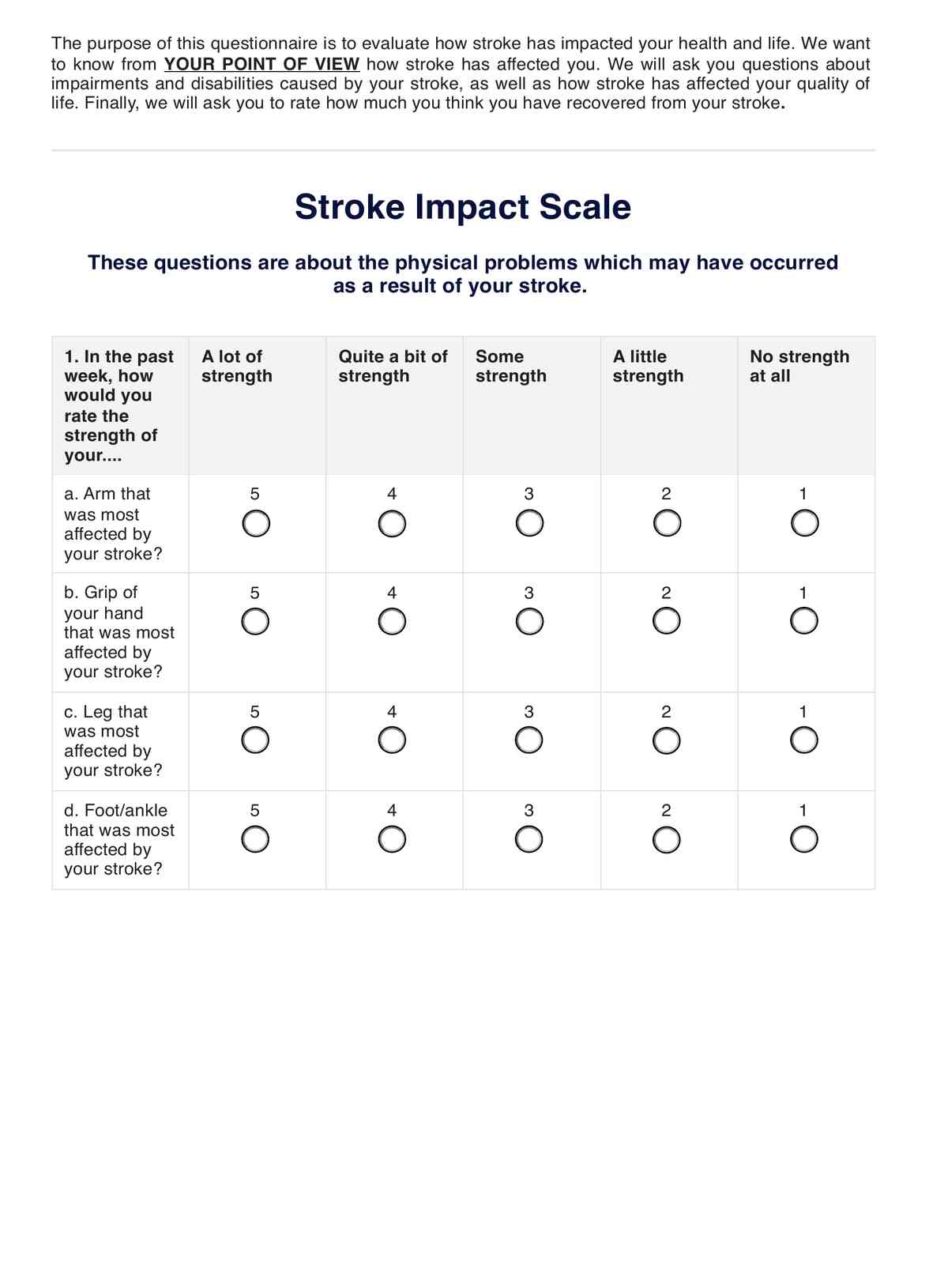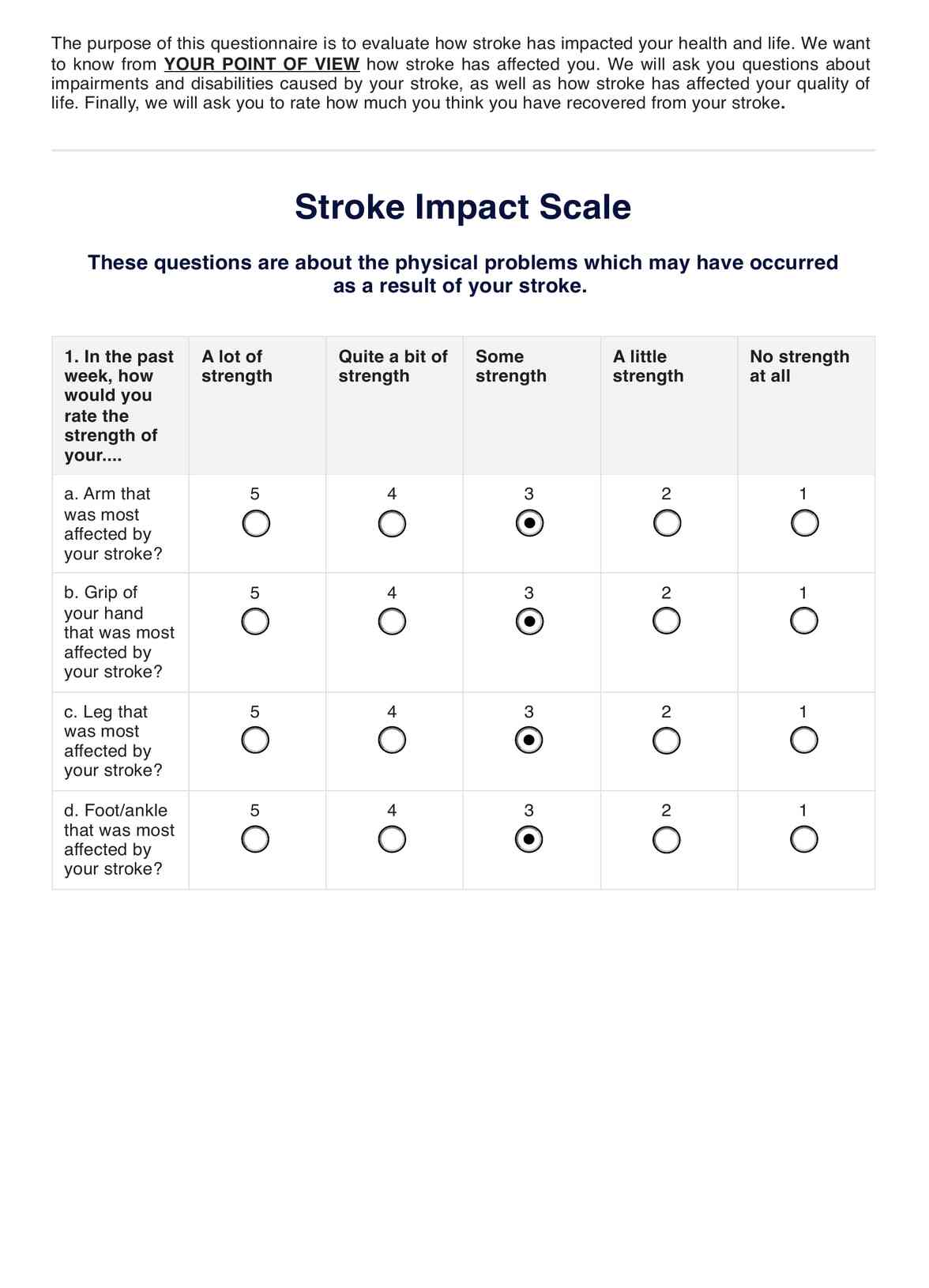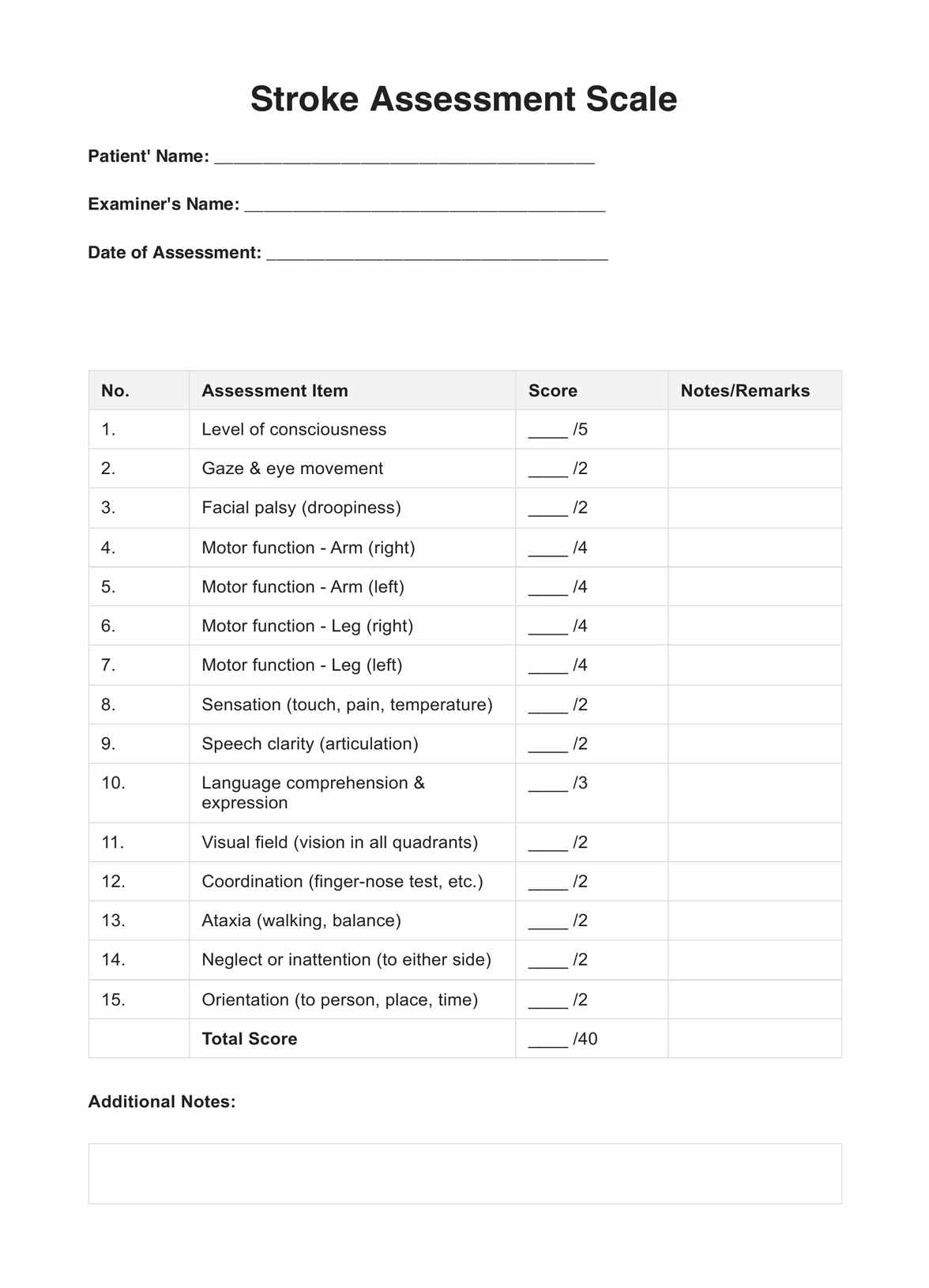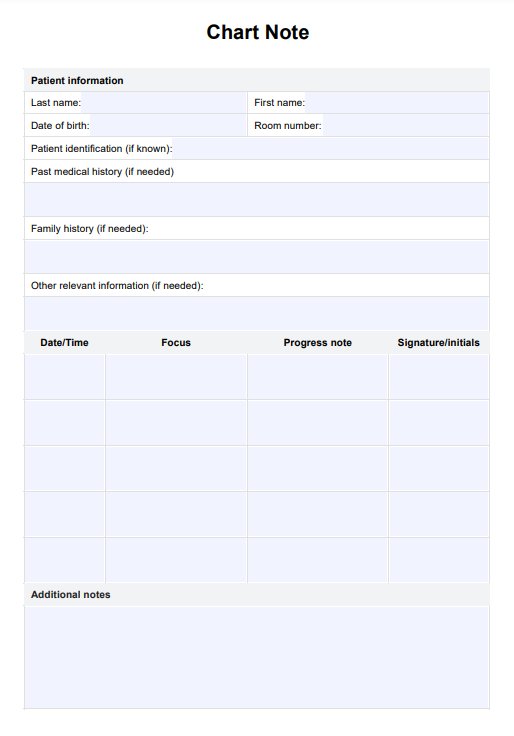Stroke Impact Scale
Assess stroke impact accurately and efficiently with our free Stroke Impact Scale Template. Prioritize patient health, and alleviate symptoms before they escalate.


What is the Stroke Impact Scale (SIS)?
Stroke, sometimes called Cerebral Infarction or Brain Attack, is a dangerous neurological condition. It is a common problem and is ranked second in the list of the top causes of death.
This brain attack happens when a particular part of the brain is not getting the necessary amount of oxygen it needs because of an artery blockage or bleeding in the brain, which leads to the death of brain cells.
The Stroke Impact Scale (SIS) is a self-report assessment used to assess stroke patients' and survivors' quality of life. Whether they’ve had an acute stroke or a chronic stroke, the Stroke Impact Scale will gather information about stroke impact, health status, physical functioning, and more about patient’s lives post-stroke.
The great thing about the Stroke Impact Scale is that it creates an opportunity for a comprehensive and patient-centered assessment. The answers are based on what patients think about their health status and quality of life, not what a healthcare professional observes.
This brief assessment should give healthcare professionals an idea about stroke survivors' physical and social functioning. It will help them develop treatment plans that cover clinical rehabilitation efforts, interventions, providing the necessary support (especially for activities of daily living), and treatment goals.
Stroke Impact Scale Template
Stroke Impact Scale Example
Area of Assessment of the Stroke Impact Scale (SIS)
The Stroke Impact Scale’s target population are stroke patients and stroke survivors, and the assessment aims to examine the following domains:
- Strength Domain: this consists of four items that evaluate a person's physical strength after having a stroke
- Hand Function Domain: this consists of five items that evaluate the patient’s fine motor skills, like how they can manipulate objects and hold things
- ADL/IADL Domain: this consists of 10 items that assess how effectively people can perform activities of daily living like bathing, getting dressed, eating, etc. post-stroke
- Mobility Domain: this consists of nine items that assess how well a person can be mobile at home and outside post-stroke
- Communication Domain: this consists of seven items that assess how well stroke patients can communicate with others post-stroke
- Emotion Domain: this consists of nine items that examine the overall emotional well-being of a patient after being treated for a stroke
- Memory and Thinking Domain: this consists of seven items that assess how much of their memory and thinking was impacted by the stroke
- Participation Domain: this consists of eight items that assess how a stroke has impacted a person’s capability to participate in activities now compared to the times before the stroke
Each item for each domain has preset items. All a person has to do is select which rating applies to them per item. They must pick a number from 1 to 5.
At the end of the Stroke Impact Scale (SIS) is a single-item domain where they rate their overall stroke recovery.
Available Versions of the Stroke Impact Scale (SIS)
The Stroke Impact Scale (SIS) version we’re discussing is the Stroke Impact Scale (SIS) 3.0.
There are two other available versions that you can use:
Stroke Impact Scale 16 (SIS-16)
This was developed by Duncan et al. back in 2003 to account for issues raised regarding sensitivity concerning differences in physical functioning in functional measures of stroke outcome.
It only focuses on the following domains: ADL/IADL, mobility, and hand function.
It only has 16 items. The first seven revolve around ADL/IADL. The following eight revolve around mobility. The last one is for hand function.
Short Form Stroke Impact Scale (SF-SIS)
This is a modified version created by Jenkinson et al. (2013). It only has eight items. Each item corresponds to a domain, and the developers selected each question based on which one correlates highly with the total domain score.
The answer choices for each question are: could not do it at all = 1 point, very difficult = 2 points, somewhat difficult = 3 points, a little difficult = 4 points, not difficult at all = 5 points.
Please note professionals at the University of Kansas Medical Center developed the Stroke Impact Scales.
Which Healthcare Professionals Can Use the Stroke Impact Scale (SIS) 3.0, and Is Training Required?
The Stroke Impact Scale 3.0 is a self-report assessment. Stroke patients will be the ones answering them. If they are physically unable to do so, their loved ones, friends, or caregivers will help them answer.
It can also be administered and conducted like an interview by the following healthcare professionals if the scale is being answered in a clinical setting:
- Nurses: they can use this scale on behalf of neurologists to assess patients and their lives post-stroke;
- Neurologists: they can use this scale and the results to create treatment plans;
- Rehabilitation specialists: they can use this scale and the results to determine how to rehabilitate stroke patients in terms of speech and motor functions;
- Psychologists: they can use this scale and the results to examine the psychological impact of stroke and determine what mental health-related treatment can help;
- Researchers and psychometricians can use this scale and the results in research settings to analyze stroke-specific outcome measures and global stroke recovery if the scales yield good test-retest reliability, which version of the SIS showed the most excellent accuracy, and more.
The Stroke Impact Scale 3.0 doesn’t require formal training to administer. The University of Kansas Medical Center SIS information page has instructions on helping it.
How Do You Interpret the Stroke Impact Scale - SIS 3.0 Scores?
Each item of the Stroke Impact Scale - SIS 3.0 is rated on a 5-point Likert scale. They’re arranged in terms of difficulty. A score of 5 means the stroke patient had no problem, while a score of 1 means they cannot do whatever action the item pertains to.
Each domain has a score. The lowest score for each domain is 0, and the highest score is 100.
To calculate domain scores, please follow this equation for each domain:
Transformed Scale = (Actual Raw Score - Lowest Possible Raw Score) ÷ Possible Raw Score Range x 100
Please note that for the Emotional Domain (3), Items 3F, 3H, and 3I are reverse scored. This means 5 = 1, 4 = 2, 3 = 3, 2 = 4, and 1 = 5.
As for the last item, stroke patients must give themselves an overall rating regarding stroke recovery. 0 means “no recovery,” while 100 means “full recovery.”
Comparing the SIS 3.0 and the SF-SIS
Stroke Impact Scales all work towards the same goal, but depending on the Stroke Impact Scale version you’re using, there are a few differences, mainly how many items they have and how they’re scored.
The SIS 3.0 covers eight domains and one item for overall recovery. Each domain has several items. One has four items, while the others generally have seven or more.
The SF-SIS is a shortened version of the SIS 3.0 and only has eight questions. Each one corresponds to a domain. It doesn’t have the scale for overall recovery. The meanings for each rating are the same as the ones for SIS 3.0.
As for calculating and interpreting the scores for the SF-SIS, please refer to the University of Kansas Medical Center’s official site for the instructions.
Purpose of the Stroke Impact Scale 3.0
As mentioned earlier, this SIS version’s purpose is the same as any other Stroke Impact Scale: to assess the different aspects of a stroke patient’s life after receiving stroke treatment.
This can be used routinely to determine how to adjust treatment/care plans and what kind of support can be provided. Using this routinely will also give healthcare professionals an idea about the treatment/care plans they’ve implemented. Are they effective? Is the patient getting better or worse? These are two questions that the scale can answer.
In What Languages Is the Stroke Impact Scale - SIS 3.0 Available?
This scale was initially created in English.
Over time, the scale was localized to the following languages:
- Brazilian (Carod-Artal et al., 2008)
- French (Cael et al., 2015)
- German (Geyh, Cieza & Stucki, 2009)
- Italian (Vellone et al., 2010; Vellone et al., 2015)
- Japanese (Ochi et al., 2017)
- Korean (Choi et al., 2017; Lee & Song, 2015)
- Nigerian (Hausa) (Hamza et al., 2012; Hamza et al., 2014)
- Portuguese (Goncalves et al., 2012; Brandao et al., 2018)
- Ugandan (Kamwesiga et al., 2016)
- United Kingdom (Jenkinson et al., 2013)
The MAPI Research Institute translated this scale to the following languages: Afrikaans, Arabic, Bulgarian, Cantonese, Czech, Danish, Dutch, Farsi, Finnish, French, German, Greek, Hebrew, Hungarian, Icelandic, Italian, Japanese, Korean, Malay, Mandarin, Norwegian, Portuguese, Russian, Slovak, Spanish, Swedish, Tagalog, Thai and Turkish.
Alternative Versions of the Stroke Impact Scale - SIS 3.0
The Stroke Impact Scale is not the only assessment for assessing stroke patients. Here are three examples of alternative reviews you can use:
- Barthel Index: this assessment is often used on stroke patients to gauge their capability of moving and performing activities of daily living without assistance
- Modified Rankin Scale: this assessment is used to assess a person’s degree of disability post-stroke
- Fugl-Meyer Assessment: this assessment gauges a person’s capability to feel sensations, balance, joint functioning, and motor functioning post-stroke
How Can Carepatron Help With the SIS?
Thanks for reading this guide! This was an excellent introduction to the Stroke Impact Scale - SIS 3.0. Suppose you request a use license from the University of Kansas Medical Center. In that case, we hope the tool helps you examine your stroke patients and determine what goes into their treatment and rehabilitation.
While you’re still here, we’d like to take some time to check out more of the Carepatron platform. We’re confident our features will help you consider us your number-one neurological assessment app and EHR platform. We won’t discuss our features here, but we’d like to highlight one of the features we’re most proud of in our resource library.
Our resource library houses a massive collection of clinical resources that cover numerous healthcare fields, practices, and topics, especially neurological problems. You can use innumerable assessments to gauge stroke patients and survivors.
We have guides about the Barthel Index and the Modified Rankin Scale that you can read if you haven’t encountered them. We also have free downloadable templates for those, so if you think those assessments can help you, feel free to download them!

Commonly asked questions
A team of researchers developed the scale. It’s available for licensing by the University of Kansas Medical Center.
There’s the original version and version 2.0. Please use 3.0, SIS-16, or the SF-SIS.
It takes 15-20 minutes to accomplish this scale.
















































































































